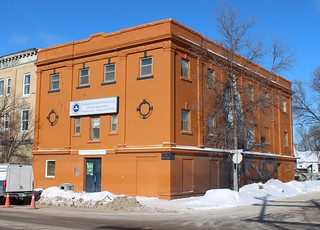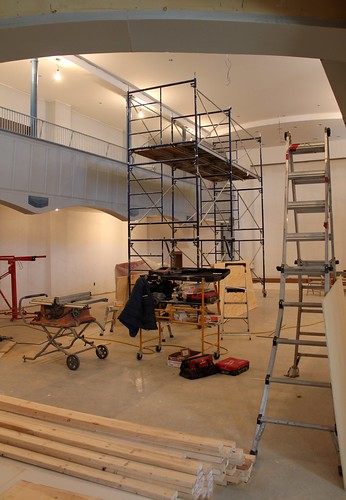Address: 635 Sargent Avenue at McGee (Map)
Architect: Samuel Hooper
Contractor:
Cost: $18,000
Most West Enders will remember 635 Sargent Avenue as "Zookhy Memorial Hall", a great place for bingo. It was built in 1906 as an International Order of Good Templars (IOGT) lodge and for decades was a cornerstone of the West End’s Icelandic community.
With the demolition of the Craik Block in 2015, this is likely the third oldest building left on Sargent Avenue after Balmoral Court (1905) and the Johnson Block / Miller Block (1905).
The building was designed by Samuel Hooper, (also see.) whose other Winnipeg works include the Law Courts building, St. Mary’s Academy and the Carnegie Library on William Avenue. At the time, Hooper was the official Provincial Architect and designing courthouses, land titles buildings, hospitals and asylums around the province. Perhaps this was a sign of the growing prominence Icelanders were gaining in the city's construction industry that he would take time out for such a project.
April 15, 1983, Lögberg-Heimskringla
After years of fundraising within the local Icelandic community, the lot was purchased for $2,500 and the cornerstone was laid in September 1906 by Sezalia Eggertson, the wife of Asbjorn Eggertson, an early board member.
The two-storey, brick and stone building cost $18,000 to construct. It contained an upper hall which could seat over 600 and a basement hall that could hold 400.
The major change in the exterior of the building, aside form the orange paint job, is the front entrance. Initially, stairs brought people from the street to the main hall entrance and the door for the lower level hall was located under the stairs. At some point before 1958 this staircase was removed.
Top: December 13, 1916, Winnipeg Free Press
Bottom: June 7, 1923, Winnipeg Tribune
The lodge opened in late January 1907 and the first large meetings held there in early February weren’t Icelandic in nature. They were political conventions to choose the local candidates for the provincial liberal and conservative parties in the upcoming provincial election. For decades, politicians and want-to-be politicians at all three levels of government used the hall to woo area voters to cast a ballot for them.
Because of its large size, the hall was rented out to many community organizations, from legions to churches to sports clubs, for their special events.
The IOGT itself, which welcomed men and women as members, was home to an Icelandic youth group, hosted Icelandic language plays, speeches, dances, conferences and other public events.
Top: November 15, 1935, Winnipeg Tribune
Bottom: August 22, 1933, Winnipeg Tribune
The Depression took its toll on many of the city's service organizations. In the early 1930s the lodge began hosting weekly fundraising events such as a whist tournament and dance or bingos, the latter were a fixture at 635 Sargent under various owners for the next 80 years.
April 15, 1983, Lögberg-Heimskringla
The fortunes of the IOGT declined in Winnipeg after the end of the Second World War. This was due to the fact that second and third generation Icelanders were more integrated into mainstream society and didn’t have the same need for such an institution. Also, attitudes towards the evils of alcohol consumption had shifted greatly over the decades.
In 1958 the lodge became an Independent Order of Foresters hall, which was another fraternal charitable organization.
In 1998 Winnserv Inc., a local non-profit agency that works with adults with intellectual disabilities, took over the operation of the bingos and went on to purchase the building on February 15, 2001.
In 1998 Winnserv Inc., a local non-profit agency that works with adults with intellectual disabilities, took over the operation of the bingos and went on to purchase the building on February 15, 2001.
In the summer of 2015 Winnserv Inc. sold the building to the Redeemed Christian Church of God and it is now known as the More Than Conqueror parish.
Renovations to the interior began in late 2015 and are expected to be completed by Spring 2016.
Jill Sellers' mural on the east wall depicts Walter Zielke “Zoohky” Ruesch. He and his bike were a long-time fixture in the West End, searching back lanes and dumpsters for electronic goods to repair and toys to fix up for area children. He became a beloved figure to many and after his death in 2002 at the age of 73, the mural was painted and the building renamed in his honour. (For the story behind the mural, read the Murals of Winnipeg entry.)
Related:
My photo album of 635 Sargent
IOGT at the Century Mark Lögberg-Heimskringla (May 1951)
Good Templars Lodge Lögberg-Heimskringla (April 1983)
Fixing things was Zoohky's road to joy Winnipeg Free Press (July 2012)
My photo album of 635 Sargent
IOGT at the Century Mark Lögberg-Heimskringla (May 1951)
Good Templars Lodge Lögberg-Heimskringla (April 1983)
Fixing things was Zoohky's road to joy Winnipeg Free Press (July 2012)










No comments:
Post a Comment